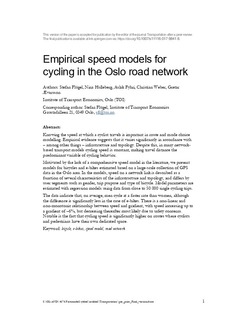| dc.contributor.author | Flugel, Stefan Markus | |
| dc.contributor.author | Hulleberg, Nina | |
| dc.contributor.author | Fyhri, Aslak | |
| dc.contributor.author | Weber, Christian | |
| dc.contributor.author | Ævarsson, Grétar | |
| dc.coverage.spatial | Norway | nb_NO |
| dc.date.accessioned | 2019-06-26T12:19:58Z | |
| dc.date.available | 2019-06-26T12:19:58Z | |
| dc.date.created | 2017-11-30T09:53:54Z | |
| dc.date.issued | 2017-11-23 | |
| dc.identifier.citation | Transportation. 2017, 1-25. | nb_NO |
| dc.identifier.issn | 0049-4488 | |
| dc.identifier.uri | http://hdl.handle.net/11250/2602329 | |
| dc.description.abstract | Knowing the speed at which a cyclist travels is important in route and mode choice modelling. Empirical evidence suggests that it varies significantly in accordance with—among other things—infrastructure and topology. Despite this, in many network-based transport models cycling speed is constant, making travel distance the predominant variable of cycling behavior. Motivated by the lack of a comprehensive speed model in the literature, we present models for bicycles and e-bikes estimated based on a large-scale collection of GPS data in the Oslo area. In the models, speed on a network link is described as a function of several characteristics of the infrastructure and topology, and differs by user segments such as gender, trip purpose and type of bicycle. Model parameters are estimated with regression models using data from close to 50,000 single cycling trips. The data indicate that, on average, men cycle at a faster rate than women, although the difference is significantly less in the case of e-bikes. There is a non-linear and non-monotonic relationship between speed and gradient, with speed increasing up to a gradient of − 6%, but decreasing thereafter most likely due to safety concerns. Notable is the fact that cycling speed is significantly higher on routes where cyclists and pedestrians have their own dedicated space. | nb_NO |
| dc.language.iso | eng | nb_NO |
| dc.publisher | Springer US | nb_NO |
| dc.rights | Attribution-NonCommercial-NoDerivatives 4.0 Internasjonal | * |
| dc.rights.uri | http://creativecommons.org/licenses/by-nc-nd/4.0/deed.no | * |
| dc.title | Empirical speed models for cycling in the Oslo road network | nb_NO |
| dc.title.alternative | Empirical speed models for cycling in the Oslo road network | nb_NO |
| dc.type | Journal article | nb_NO |
| dc.type | Peer reviewed | nb_NO |
| dc.rights.holder | © Springer Science+Business Media, LLC, part of Springer Nature 2017 | nb_NO |
| dc.description.version | acceptedVersion | nb_NO |
| cristin.unitcode | 7482,3,2,0 | |
| cristin.unitcode | 7482,2,2,0 | |
| cristin.unitcode | 7482,2,4,0 | |
| cristin.unitname | Transportmodeller | |
| cristin.unitname | Sikkerhet og atferd | |
| cristin.unitname | Miljø og klima | |
| cristin.ispublished | true | |
| cristin.fulltext | postprint | |
| cristin.qualitycode | 1 | |
| dc.identifier.doi | 10.1007/s11116-017-9841-8 | |
| dc.identifier.cristin | 1520667 | |
| dc.source.journal | Transportation | nb_NO |
| dc.source.pagenumber | 1-25 | nb_NO |

